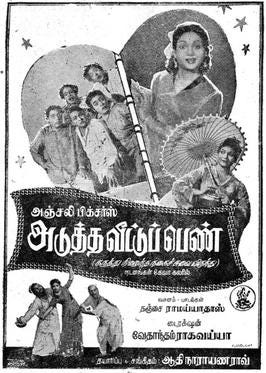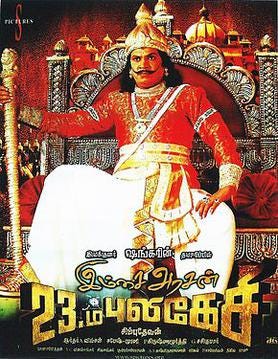Muni Cinematic Universe. Yes, that is how the Muni-Kanchana series of horror-comedy movies have come to be referred. The first installment Muniwas dished out in the year 2007. And till this date the makers continue to entertain (and terrorise) us with their flavour of comedy. Kanchana 3 wasthe biggest hit of the summer of 2019. It was the fourth film of the MCU. Amidst this, we also had a neat horror comedy in Darling (2015). But for an industry that has been around for 100+ years, why are there only a few takers for the niche genre?
In the initial years (1930s and 40s) Tamil films mainly said the stories from popular Hindu myth like Baktha Prahalada, Meerabai, Harichandra and so on, and various sub-plots of Ramayana, Mahabharata and Tamil myth and literature. There were occasional film adaptations of stage plays and stories from Tamil weeklies, like Maathruboomi and Sathi Leelavathi. And there were these set of films on popular personalities like Tenali Raman, Patinathar, and the like. Interestingly, there were also sporadic outbursts like Pakka Rowdy, Madras CID, etc. Yes, there was this comedy film Sabapthy (1941). But hands down, the loyal pet of the initial decades was mythology.
Gradually, the themes veered to the Raja-Rani domain (basically, stories on power struggle set in some faraway lands), patriotic fervour, and magical stories that were slotted under Brand Vitalaachariyaar.
1952. The Dravidian tsunami set the screens on fire with Parasakthi. Till date, Sivaji Ganesan's debut performance is the gold standard for dialog delivery in films. But as a whole the decade was filled with the likes of Madurai Veeran, Manohara, Gulebakavali and Nadodi Mannan. Yes coming back to humour, though there were ‘comedy tracks’ in films, full length, successful comedy films were not easy to locate. Sabash Meena (1958) was the one that stood out. Even if decades had passed after the roaring success of Charlie Chaplin world over, the reluctance of Tamil film makers to find comfort with full length comedy continued. But due credits to N.S.Krishnan for adding humour to Tamil films in the initial decades of its life.
Adutha Veettu Penn (1960) starring T. R. Ramachandran in the lead role provided a hilarious opening for the new decade. It was a laugh riot, a situational comedy soaked in those old tricks boys always do to impress damsels. There is this famous funny song ‘Kangalum kavi paduthey..’ that serves as a template even till this date. AVP was a truly successful comedy film. Sivaji Ganesan’s Bale Pandiya, another landmark comedy, followed it. Still comedy as a genre was not tried often. 1964. Kadhalikka Neramillali. This is a cult comedy that actor Nagesh carried so effortlessly on his shoulders. The scene where Chellapa (Nagesh playing an aspiring film director) narrates a story to his father is rib-tickling even now. Rajnikanth used a similar scene in his comeback film Chandramuki (2005), more or less to the same comic effect. Then came the crop of Nagesh-K Balachander comedy-dramas like Server Sundaram (KB as the writer), Bama Vijayam, Ethir Neechal and so on. Outside these films the concept of ‘comedy track’ was still in vogue taking a helping hand from J.P.Chandrababu, Manorama, Cho and other assorted ‘comedians’. Galatta Kalyanam with its amusing premise was a feather in the cap of the 60s. Again, Sivaji Ganesan proved his mettle with humour.

1970s was a tumultuous, milestone decade for Tamil films — it marked the generational shift from MGR-Sivaji to Rajni-Kamal; from MSV to Ilayaraja; from Raja-Rani and mythology stuff to serious social and family dramas. Also the legendary directors like KB, Bharathiraja and Mahendran delivered their best in this decade. But what about comedy films? Sorry, the species had just slipped from ‘Endangered’ to ‘Critically endangered’.
Thillu Mullu (a Hindi film remake), the evergreen comedy heralded the 1980s. It presented a very new dimension of Rajnikanth. Supported by Thengai Srinivasan, Sowcar Janaki and an ensemble of cast that includes even Nagesh and Kamal Hassan in minor roles, the film became a benchmark for the genre. Due to the continued efforts of film makers and actors like K.Bhagyaraj (Indru Poi Naalai Vaa, Dhavani Kanavugal), R.Pandirajan (Aan Paavam, Oorai Therunjukitten) and Visu (Dowry Kalyanam, Manal Kayiru), the genre continued to be relevant. In fact the comedy films gained traction in Kollywood. But, while many of the these films were great comedies, the maker comedy film of the decade was still Thillu Mullu released in 1981. The eight years that followed only helped the genre escape the deterioration from ‘Critically endangered’ to ‘Near-extinct’.
Yes, there were great ‘comedy tracks’ during the period, performed exceedingly well by the comic legends like Goundami-Senthil. The 80s too witnessed a revolution in Tamil cinema. Mani Ratnam. But comedy was never his forte. And the auteur even dropped the ‘comedy tracks’ from his films very soon, after attempting it for one last time in Agni Natchathiram(1988).
So this was the B.C. of Tamil comedy films. Before ‘Crazy’.
Now let us move to anno Domino (A.D.), in the year of Tamil comedy God ‘Crazy’ Mohan. It was 17th October, 1990, and Michael Mathana Kama Rajan the greatest Tamil comedy of all times got released. The very previous year, with Apoorva Sagodharargal Crazy had established himself as a real talent on humour and dialog writing. ‘Sir.. neenga engeyo poitenga!’ still lingers in the air. Even Crazy’s Kathanayagan (1988) had memorable funny moments (‘Gaja ka dost’). But with MMKR, Crazy took the onscreen comedy to an altogether higher plane, and set a fresh benchmark. And it was too high for anyone to even attempt beating. Yes, doing all the four titular roles Kamal Hassan played an extraordinary part in creating the onscreen magic of humour.
International Decade of Tamil Comedy Films
The Crazy-Kamal combo went on to roll out one comedy after another — Magalir Mattum, Sathi Leelavathi, Avvai Shanmugi and Kadhala Kadhala, all in the same decade. Crazy also collaborated (less successfully) with others, and gave memorable comedy film like Chinna Mapillai. The decade also had non-Crazy hits like Nadigan (1990, a 1962 Hindi film remake), Singara Velan (1992) and Ullathai Allithaa (1996) that were pretty high on humour — but nothing could outwit the Crazy waves that consistently lapped the pristine shores of onscren humour. The new millennium too kick started with the Crazy-Kamal combo. Thenali (2000), Panchathantiram (2002),Pammal K Samandham (2002) and Vasool Raja MBBS (2004, a Hindi film remake). Switch on your telly and randomly play any Tamil comedy channel, and don’t be surprised if you end up watching clips from any of these. The other film makers collected the baton and continued to run up the humour track with all sincerity. Soon we had two more cult classics of comedy — Imsai Arasan 23-aam Pulikesi (2006) and Chennai 600028 (2007). Well, the decade of 2000s was easily the most humour-packed years of Tamil cinema. May be the UNO should have it as the International Decade of Tamil Comedy Films.

Now, why horror-comedy has taken (is taking) so long to evolve? Simple. Even full length comedy has established itself only in the recent decades. Only in the A.D., comedy has been commanding a place for itself. Before Crazy, there were hardly any takers even for the evergreen material of slapstick or the comedy of errors. But just person (teamed up with a supreme actor) changed the pitch; and also the way games were played.
There have been directors and writers who have given us serial blockbusters. Ellis R. Dungan, B. R. Panthulu, S.P.Muthuraman, P.Vasu, Panchu Arunachalam, Gangai Amaran, Shankar and many more. It is a big deal. But to hand out guarantee consistent hits in just the genre of comedy — it is actually a big deal. When was the last time you just laughed so easily? (Unless the person cracking the joke was your boss.) Before Crazy there were just old sprinklers struggling to keep up the grass green. In A.D. the genre progressed from critically endangered to just vulnerable. A giant leap for any species. The genre blossomed.
Now, in the second decade of the third millennium, in spite of gems like Soodhu Kavvum (2013) we seem to be staring at a scenario of over-population. The makers are worried more about the numbers than about the DNA strength. But that is another story, unfolding every Friday. The latest, weakest member being Dharmaprabhu.
Maestro Ilayaraja — just a single person defined the whole of Tamil cinema music throughout the 1980s. Other than him there was perhaps no other person of any section in the industry, at any point in time, who stood as the only identity for his field of work; the one who had total domination. The sky always had a couple of shining stars and a few dazzling shooting stars. May be a rainbow here or a full moon there. But never a sole star glittering with a beaming smile. But from the year 1990, the comedy sky had one such star. It was ‘Crazy’ Mohan.


